lordroel
Administrator
Posts: 68,031 
Likes: 49,426
|
Post by lordroel on Dec 14, 2018 14:12:49 GMT
What if, the Saunders-Roe SR.A/1 jet-propelled fighter flying boatWorld War II in the Pacific presented challenges to the operation of aircraft that weren’t faced by pilots in Europe. Most notable was the fact that much of the the action took place over the open ocean, far from land bases. Large bombers possessed the necessary range for long-distance missions, but fighters did not. Japan addressed this problem by modifying the famed Mitsubishi A6M Zero by adding floats so it could operate from any smooth patch of water. However, the floats caused a considerable amount of drag and rendered the A6M2-N “Rufe” unable to tangle successfully with Allied fighters. But the idea of a waterborne fighter remained attractive, and the British firm Saunders-Roe tried to overcome the problems suffered by a float plane fighter by eliminating the floats altogether and replacing the propeller engine with a more powerful turbojet. The result was the SR.A/1, unofficially nicknamed the Squirt, the world’s first jet-powered flying boat. Outwardly, the SR.A/1 resembled most flying boats of the era. It had a boat-like hull with a high shoulder-mounted wing, and a tail raised above the water. Where it differed significantly was in its power plant. Instead of traditional piston engines, the Squirt was powered by two turbojets housed in the fuselage and fed by a large air intake in the nose. The Metropolitan-Vickers Beryl turbojets were the first to be designed with an axial flow compressor and, by the time they had been further developed and installed in the third SR.A/1 prototype, the Beryl had become one of the most powerful turbojets of its era, providing the Squirt with a top speed of 512 mph. The Squirt featured retractable outer stabilizing floats and an automatic mooring system so the pilot could dock without assistance and without getting his feet wet, as well as long beaching gear which allowed the fighter to taxi onto dry land. The single pilot was placed in an ejection seat high on the fuselage, but this severely hindered his visibility, and this deficiency was exacerbated when the clear canopy was replaced by reinforced canopy that all but eliminated rearward visibility. Though armament was never fitted, Saunders-Roe planned for four 20mm cannons in the nose and up to 1,000 pounds of bombs or rockets housed internally. The Squirt’s maiden flight took place on July 16, 1947, and while it showed good handling for such a large, thick-winged fighter, there was one insurmountable problem: the war had ended, and there was simply no mission for a flying boat fighter. Also, production of the engines had ceased when Metrovick left the gas turbine engine business, so there were very few engines on hand. Testing of the prototypes continued, but, with no role to play, the project was eventually shelved. It was resurrected briefly in 1950 during the Korean War, but by then there was only one SR.A/1 remaining, the others having been lost to crashes, and the project was officially retired the following year. The sole remaining Squirt now resides at the Solent Sky aviation museum in Southampton. YouTube clip (Saunders Roe Jet Flying Boat,1947)
But some ideas are hard to die, and the demise of the Squirt was not the last hurrah for a water-based jet fighter. Convair made an attempt with the F2Y Sea Dart in 1953, but, like the SR.A/1, the difficulties of flying a small jet fighter from the surface of the water, and the compromises in performance, consigned the Sea Dart to a similar fate. Picture I
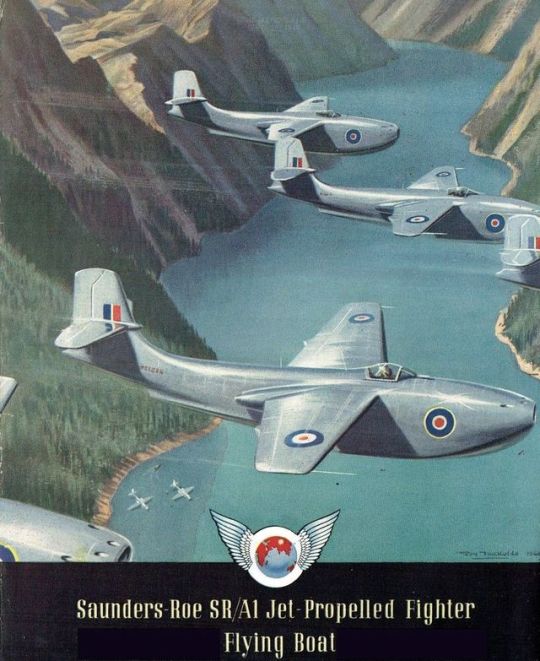 Picture II Picture II
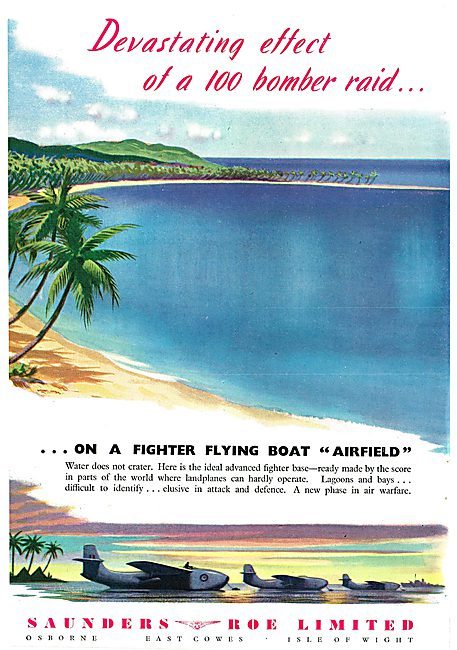 Picture III Picture III
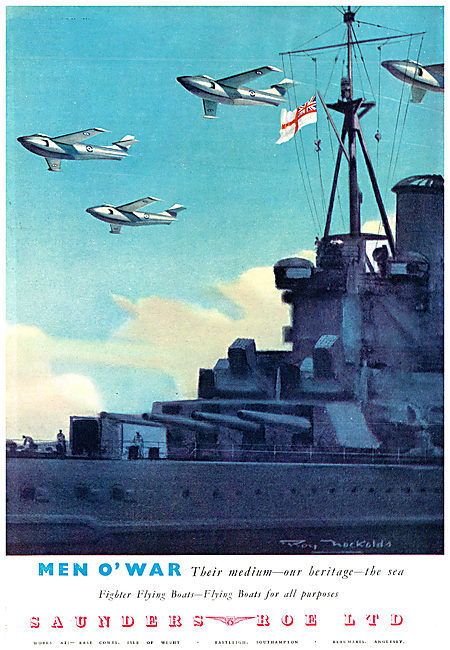 Picture IV Picture IV

|
|
stevep
Fleet admiral
Member is Online
Posts: 24,854 
Likes: 13,235
|
Post by stevep on Dec 14, 2018 18:27:46 GMT
Lordroel
I think even if some version was deployed it would probably be in relatively small numbers, which would make it unattractive to maintain in peacetime or upgrade/replace. As such its likely to have a fairly short service life.
Steve
|
|
lordroel
Administrator
Posts: 68,031 
Likes: 49,426
|
Post by lordroel on Dec 14, 2018 18:41:13 GMT
Lordroel I think even if some version was deployed it would probably be in relatively small numbers, which would make it unattractive to maintain in peacetime or upgrade/replace. As such its likely to have a fairly short service life.
Steve
Would be fun to see the RAF using them, ore would it mostly be the FAA that would operate them. |
|
stevep
Fleet admiral
Member is Online
Posts: 24,854 
Likes: 13,235
|
Post by stevep on Dec 14, 2018 23:52:52 GMT
Lordroel I think even if some version was deployed it would probably be in relatively small numbers, which would make it unattractive to maintain in peacetime or upgrade/replace. As such its likely to have a fairly short service life.
Steve
Would be fun to see the RAF using them, ore would it mostly be the FAA that would operate them.
Could be either in theory as both would have interests in the late 40's and early 50's in operating from isolated locations where there were island, or alternatively at land using lakes. [Although in the latter case in most instances I suspect normal land based a/c would be more efficient.]
|
|
lordroel
Administrator
Posts: 68,031 
Likes: 49,426
|
Post by lordroel on Dec 15, 2018 6:53:01 GMT
Would be fun to see the RAF using them, ore would it mostly be the FAA that would operate them. Could be either in theory as both would have interests in the late 40's and early 50's in operating from isolated locations where there were island, or alternatively at land using lakes. [Although in the latter case in most instances I suspect normal land based a/c would be more efficient.]
Could we see the Royal Navy deploy more seaplane carriers in order to support the Saunders-Roe SR.A/1, |
|
stevep
Fleet admiral
Member is Online
Posts: 24,854 
Likes: 13,235
|
Post by stevep on Dec 15, 2018 10:44:20 GMT
Could be either in theory as both would have interests in the late 40's and early 50's in operating from isolated locations where there were island, or alternatively at land using lakes. [Although in the latter case in most instances I suspect normal land based a/c would be more efficient.]
Could we see the Royal Navy deploy more seaplane carriers in order to support the Saunders-Roe SR.A/1,
Possibly but how much more difficult would it be using ordinary carriers and standard a/c? There might be advantages from having a seaplane but unless they can be launched from a deck as well their limited by sea-state as seaplanes can only really operate in pretty calm waters. Also if its a seaplane carrier, since the SR.A was a fighter would you need other seaplanes for say bomber and torpedo type roles. Another factor, assuming they can only land/take off from the sea is that it would take longer to launch and retrieve strikes as each plane would have to lowered by crane to the sea and then winched up afterwards. Which also means the carrier and any ships with it are more vulnerable as it has to stay pretty much motionless for a long period. Similarly a/c taking off from the deck can make use of the wind off a fast carrier and possibly more important with heavy jet a/c a catapult, neither of which would be available for a plane launched off the sea.
Thinking about it while you might want a support ship which could use the same anchorage and supply spares, supplies, do repairs etc I don't think a specialised carrier - or you would probably need two for when one's in dock/refit - would be worthwhile.
|
|
lordroel
Administrator
Posts: 68,031 
Likes: 49,426
|
Post by lordroel on Dec 15, 2018 16:21:34 GMT
Could we see the Royal Navy deploy more seaplane carriers in order to support the Saunders-Roe SR.A/1, Possibly but how much more difficult would it be using ordinary carriers and standard a/c? There might be advantages from having a seaplane but unless they can be launched from a deck as well their limited by sea-state as seaplanes can only really operate in pretty calm waters. Also if its a seaplane carrier, since the SR.A was a fighter would you need other seaplanes for say bomber and torpedo type roles. Another factor, assuming they can only land/take off from the sea is that it would take longer to launch and retrieve strikes as each plane would have to lowered by crane to the sea and then winched up afterwards. Which also means the carrier and any ships with it are more vulnerable as it has to stay pretty much motionless for a long period. Similarly a/c taking off from the deck can make use of the wind off a fast carrier and possibly more important with heavy jet a/c a catapult, neither of which would be available for a plane launched off the sea. Thinking about it while you might want a support ship which could use the same anchorage and supply spares, supplies, do repairs etc I don't think a specialised carrier - or you would probably need two for when one's in dock/refit - would be worthwhile.
You mean seaplane tenders instead of seaplane carriers. |
|
stevep
Fleet admiral
Member is Online
Posts: 24,854 
Likes: 13,235
|
Post by stevep on Dec 15, 2018 18:17:01 GMT
Possibly but how much more difficult would it be using ordinary carriers and standard a/c? There might be advantages from having a seaplane but unless they can be launched from a deck as well their limited by sea-state as seaplanes can only really operate in pretty calm waters. Also if its a seaplane carrier, since the SR.A was a fighter would you need other seaplanes for say bomber and torpedo type roles. Another factor, assuming they can only land/take off from the sea is that it would take longer to launch and retrieve strikes as each plane would have to lowered by crane to the sea and then winched up afterwards. Which also means the carrier and any ships with it are more vulnerable as it has to stay pretty much motionless for a long period. Similarly a/c taking off from the deck can make use of the wind off a fast carrier and possibly more important with heavy jet a/c a catapult, neither of which would be available for a plane launched off the sea. Thinking about it while you might want a support ship which could use the same anchorage and supply spares, supplies, do repairs etc I don't think a specialised carrier - or you would probably need two for when one's in dock/refit - would be worthwhile.
You mean seaplane tenders instead of seaplane carriers.
Basically yes. If their operating from 'fixed' locations then you need some sort of tenders and repair capacity but a flight deck isn't really needed and having a force trying to operate from such a carriers has serious problems as I mentioned in the previous post.
|
|
lordroel
Administrator
Posts: 68,031 
Likes: 49,426
|
Post by lordroel on Dec 15, 2018 18:31:08 GMT
You mean seaplane tenders instead of seaplane carriers. Basically yes. If their operating from 'fixed' locations then you need some sort of tenders and repair capacity but a flight deck isn't really needed and having a force trying to operate from such a carriers has serious problems as I mentioned in the previous post.
So like a seaplane tender operating from in a lagoon ore a bay like that from Picture II. Also found another pictures of the Saunders-Roe SR.A/1 1950 advertisement. 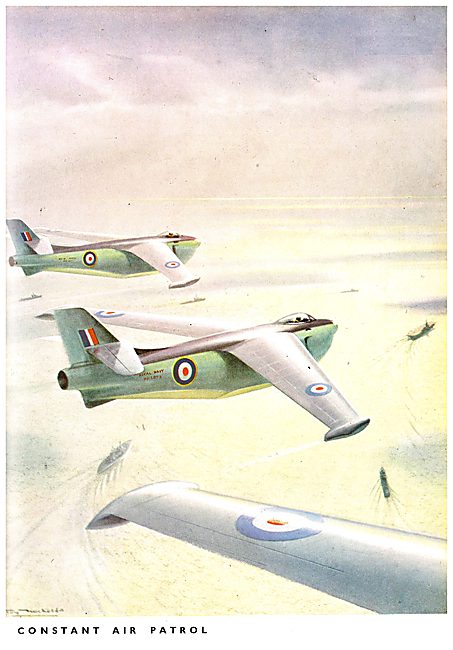 |
|
Deleted
Deleted Member
Posts: 0
Likes:
|
Post by Deleted on Dec 15, 2018 23:48:33 GMT
It's safer to operate Supermarine Attackers, or Hawker Sea Hawks from carriers - jet flying boats tend to hit things submerged underwater, rocks, roots, coral, pieces of metal.
It's what happened to two of the three prototypes.
The two 4000lb thrust Metrovick engines would be better off in something with an arrestor hook,
|
|
stevep
Fleet admiral
Member is Online
Posts: 24,854 
Likes: 13,235
|
Post by stevep on Dec 16, 2018 12:24:20 GMT
It's safer to operate Supermarine Attackers, or Hawker Sea Hawks from carriers - jet flying boats tend to hit things submerged underwater, rocks, roots, coral, pieces of metal. It's what happened to two of the three prototypes. The two 4000lb thrust Metrovick engines would be better off in something with an arrestor hook,
That's another good point I forgot. Especially since early jets especially were pretty heavy and so you need a long take-off.
|
|
lordroel
Administrator
Posts: 68,031 
Likes: 49,426
|
Post by lordroel on Dec 16, 2018 15:22:33 GMT
It's safer to operate Supermarine Attackers, or Hawker Sea Hawks from carriers - jet flying boats tend to hit things submerged underwater, rocks, roots, coral, pieces of metal. It's what happened to two of the three prototypes. The two 4000lb thrust Metrovick engines would be better off in something with an arrestor hook, That's another good point I forgot. Especially since early jets especially were pretty heavy and so you need a long take-off.
But a lake,lagoon ore a bay can provide that also, ore am i wrong. |
|
stevep
Fleet admiral
Member is Online
Posts: 24,854 
Likes: 13,235
|
Post by stevep on Dec 16, 2018 19:13:13 GMT
That's another good point I forgot. Especially since early jets especially were pretty heavy and so you need a long take-off.
But a lake,lagoon ore a bay can provide that also, ore am i wrong.
It would probably be an even bigger problem in a lagoon, lake, bat etc than the open ocean, although such places are more likely to have calm water than the open ocean. Either way I can see a lot of problems with a seaplane a/c depending on the circumstances.
|
|
lordroel
Administrator
Posts: 68,031 
Likes: 49,426
|
Post by lordroel on Dec 16, 2018 19:27:01 GMT
But a lake,lagoon ore a bay can provide that also, ore am i wrong. It would probably be an even bigger problem in a lagoon, lake, bat etc than the open ocean, although such places are more likely to have calm water than the open ocean. Either way I can see a lot of problems with a seaplane a/c depending on the circumstances.
Well still i like the advertisement they made in order to sell them, they have a little bit of alternate history behind them. Another YouTube clip about the Saunders-Roe SR.A/1 Flying Boat Fighter Aircraft. From this site Saunders-Roe i got this as it might have looked in Royal Navy markings. 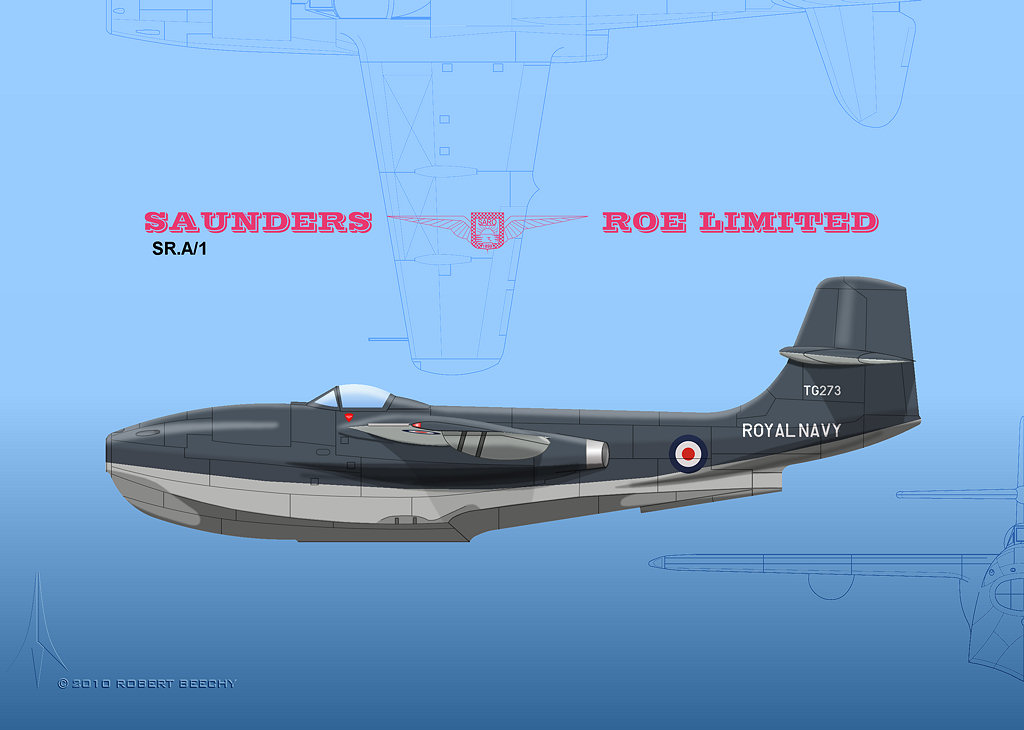 |
|
|
|
Post by riggerrob on Sept 18, 2020 18:03:04 GMT
If Britain had retained more of her colonies after WW2, seaplanes would have proven valuable in suppressing local rebellions of invasions from neighboring countries (e.g Indonesia invading Brunei). In that scenario, jet seaplanes do not need to out-perform the latest Migs, merely locally owned WW2 surplus prop jobs. At 500 mph, Saunders' jet seaplane easily out-ran any prop job (400 mph at best).
Also consider that many British colonies lacked the huge, concrete runways build on American-occupied islands.
Conventional aircraft carriers are frightfully expensive. Post WW2, Argentina, Australia, Brazil, Britain, Canada, China, India, Italy, France, Spain, USSR, etc. all struggle to afford conventional aircraft carriers.
Many seaplane tenders and battleships had catapults launch light observation airplanes.
Far more Second-World navies could afford smaller seaplane tenders, ergo more could afford jet seaplanes later into the 1950s.
|
|














